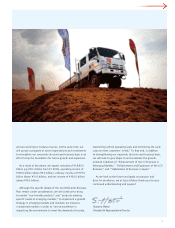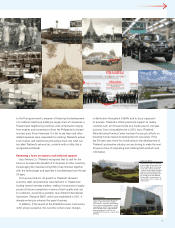Isuzu 2014 Annual Report Download - page 19
Download and view the complete annual report
Please find page 19 of the 2014 Isuzu annual report below. You can navigate through the pages in the report by either clicking on the pages listed below, or by using the keyword search tool below to find specific information within the annual report.
17
Financial
Section
Management’s Discussion and Analysis of Financial Condition and Results of Operation
Exchange rate fluctuations caused by the weakness of the
yen combined with material cost reductions to contribute ¥25.3
billion and ¥20.2 billion, respectively, while sales and model mix
fluctuations added ¥7.2 billion. Offsetting these were factors
including a ¥4.8 billion increase in costs associated with the
growth in sales and ¥4.5 billion in economic fluctuations.
As a result, Isuzu’s operating margin increased to 9.9%,
compared to 7.9% for the previous year.
4. Non-operating gains/losses
In fiscal 2014, Isuzu posted a non-operating gain of ¥12.3
billion, an improvement of ¥1.4 billion from the previous year.
Equity-method investment income fell ¥300 million from the
previous year to ¥10.5 billion.
Reduction of interest-bearing debt resulted in a net interest
(interest and dividends minus interest expenses) gain of ¥1.9
billion, an improvement of ¥1.6 billion compared to the previous
year. This was augmented by a foreign exchange gain of ¥100
million, compared to a foreign exchange loss of ¥1.7 billion for the
previous year.
5. Extraordinary gains/losses
In fiscal 2013, Isuzu posted an extraordinary loss of ¥3.5
billion, reflecting extraordinary losses including loss on disposal
of noncurrent assets, impairment loss, and loss on reevaluation of
investments in nonconsolidated subsidiaries and credit obligations,
and extraordinary income including gain from the sale of fixed
assets, gain on sale of investment securities, and compensation
income for expropriation.
In fiscal 2014, Isuzu posted an extraordinary gain of ¥1.8 billion,
reflecting an improvement of ¥5.3 billion from the previous year.
Key factors reflect extraordinary losses, including loss on disposal
of noncurrent assets, loss on change in equity, and loss on step
acquisitions, and extraordinary income including gain from the
sale of fixed assets, gain on sale of investment securities, and gain
on negative goodwill.
6. Taxes
Isuzu’s net tax expense in fiscal 2013 including current income
taxes and deferred income taxes was ¥28.3 billion. In fiscal 2014,
the net tax expense was ¥44.6 billion.
7. Minority interests
Minority interests consist primarily of profits returned to the
minority shareholders of Isuzu’s locally incorporated subsidiaries
in the ASEAN region, China, and North America, and its Japanese
parts manufacturers. Minority interests in fiscal 2014 increased to
¥24.4 billion, compared to ¥13.3 billion in fiscal 2013.
8. Net income
The Group posted a net profit of ¥119.3 billion in fiscal 2014,
an improvement of ¥22.7 billion from the previous year. Net
income per share came to ¥70.43.
The following provides an analysis of the financial condition and
results of operation in fiscal 2014. The following information
contains forward-looking statements that reflect the judgment of
management as of June 27, 2014.
(1) Significant accounting policies and estimates
The consolidated financial statements of the Isuzu Group
are prepared in accordance with generally accepted accounting
principles of Japan. In the preparation of these statements, the
amounts recorded for items including allowance for doubtful
accounts, inventory, investments, income taxes, retirement
benefits, and provision for product warranties are estimates that
reflect the judgment of management. Due to the uncertain nature
of estimates, in some cases actual results may vary from initial
estimates, and this may have a negative impact on business results.
(2) Results of operations
1. Overview of fiscal 2014
The Company posted sales of ¥1,760.8 billion (up 6.4% from
the previous year), operating income of ¥174.2 billion (up 33.2%
from the previous year), ordinary income of ¥186.6 billion (up
31.7% from the previous year), and net income of ¥119.3 billion
(up 23.6% from the previous year).
2. Net sales
In fiscal 2014, Isuzu’s consolidated-basis sales rose 6.4% from
the previous year to ¥1,760.8 billion.
In the domestic commercial vehicle market, Isuzu maintained
its high market share through the introduction of products with
superior fuel efficiency and economy, capturing 33.4% of the
medium-duty and heavy-duty trucks market (down 0.5 points
from the previous year) and 39.6% of the light-duty (2-3 ton)
truck market (up 0.1 points from the previous year). Demand for
medium- and heavy-duty trucks rose to 79,929 (up 16.6% from
the previous year) and demand for light-duty trucks rose to 91,520
(up 21.0% from the previous year) due in part to post-earthquake
reconstruction demand and the government’s economic
stimulation measures. As a result, domestic sales rose to ¥630.5
billion (up 6.5% from the previous year).
Sales in Asia fell 1.2% from the previous year to ¥595.7 billion.
Although the market environment in Thailand slowed more than
had been expected at the beginning of the fiscal year, the Group
continued to maintain its high share with 31% of the Thai market.
North American sales rose 36.3% from the previous year to
¥98.6 billion, reflecting growth in demand due to a trend towards
recovery in the U.S. economy.
Sales to other regions grew 12.3% to ¥435.8 billion, reflecting
increased sales, particularly in the Middle East, Africa, and other
regions.
3. Operating income
Operating income in fiscal 2014 was ¥174.2 billion, up 33.2%
from a year earlier.
























